Correction: NTIA/ITS Measurements 225-400 MHz
For example here are several recent NTIA occupancy measurement reports that include 225-400 MHz data:
- NTIA Technical Report TR-14-502: Broadband Spectrum Survey in the Chicago, Illinois, Area - Data taken in September 2012 and published in April 2014.
- NTIA Technical Report TR-13-496: Broadband Spectrum Survey in the Denver Area - Data taken in June 2011 and published in August 2013
- NTIA Technical Report TR-14-498: Broadband Spectrum Survey in the San Diego, California, Area - Data taken in May and June 2012 and published in November 2013
In addition, while many previous NTIA/ITS reports did not include 225-400 MHz, these 2 did:
- NTIA Technical Report TR-95-321: Broadband spectrum survey at Denver, Colorado - Data taken in September and October of 1993 and published in September 1995
- NTIA Technical Report TR-97-334: Broadband spectrum survey at San Diego, California - Data taken in September and October of 1993 and published in December 1996.
We apologize to NTIA and our readers for presenting information that was not correct and not noticing the change in late 2013 in this area. We are correcting all the past posts that discuss this issue to include a link to this correction.
IIT's Spectrum Observatory: Some Questions Its Data Could Answer
While traveling this week I visited the Illinois Institute of Technology in Chicago and met with Dennis Roberson, an old acquaintance who had invited me to give a seminar. Dennis showed me around the beautiful Mies van der Rohe-designed campus and kindly arranged that the seminar be given in S. R. Crown Hall , a National Historic Landmark designed by van der Rohe.
I was particularly fascinated by the NSF-supported Spectrum Observatory that Dennis has described as follows:
Spectrum is a scarce natural resource that we depend on to an ever increasing degree for our social interactions, our protection and emergency services at the national and global level and the efficient conduct of business both here and around the world. This resource is extremely valuable commanding prices in the U.S. in the range of $250,000,000 per MHz for prime spectrum property. Even the President has become directly involved in an effort to move 500 MHz of spectrum to commercial broadband providers (usually cell phone service providers) in an attempt to spur economic growth, create jobs and to help to resolve the Federal Budget deficit. Given its value and importance, surprisingly little is really known about the current usage and the trends in the spectrum occupancy in the various geographies in the U.S. and around the world. To help resolve this issue, Illinois Institute of Technology through its Wireless Network & Communications Research Center (WiNCom) developed a Spectrum Observatory to monitor the spectrum occupancy in the "Loop," the business center of the City of Chicago.
As shown at left, the Spectrum Observatory covers 30-6000 MHz. It has been operating since July 2007 from a 22 story site at the IIT campus a few km south of the downtown Chicago. The basic arrangement and some of the data collected are reviewed in a DySPAN 2011 paper.
225-400 MHz Band Data. Some data in the DySPAN paper shows occupancy in the 225-406 MHz band. A previous post here reviewed NTIA’s disinterest in reviewing occupancy of this band although it has reviewed occupancy of nearby federal bands. 225-400 MHz is mostly a military aeronautical mobile band. There are some other things in it including mobile satellite links that go back to the Cold War.
There is a military base in downtown San Diego that uses this band, but not in other urban areas where there are a real spectrum shortages. Shared use of 225-400 MHz, perhaps on an interruptible spectrum basis, could help add spectrum to meet real US needs. NTIA’s reluctance to explore this by collecting data shows the basic problem of US spectrum policy in the current arrangements and the need for the recent PCAST federal spectrum recommendations. But to explore the feasibility of shared use we need real data on its present use and the IIT data is a great step in the right direction. Preliminary analysis in the DySPAN paper shows that for the period 2008 - 2010 the occupancy of 225-406 MHz had a maximum less than 20%. This initial analysis could be a good starting point for more detailed analysis by FCC and NTIA of this NSF-funded data collection.
Estimating Radio Noise Trends. Another interesting question that might be addressed from this unique data source is long range trends in spectrum noise. There is anecdotal evidence that it is increasing, but no real data. TV channel 37, 608-614 MHz, is a primary radio astronomy allocation and is basically unused - although this is some minimal licensed use for critical care medical telemetry in hospitals. A long term examination of this or other channels that should not be used in Chicago could reveal hard data on whether background noise is urban areas is changing.
===
The IIT Radio Observatory is a unique resource and kudos to IIT for proposing and operating it and to NSF for funding it. Unfortunately it is not that well known despite several published papers. Hopefully better understanding of this resource can lead to more informed spectrum policy decisions. But then again I once had a boss at FCC who was head of OET who said “Never ask a question unless you are prepared to hear the answer.”
UPDATE
See http://www.marcus-spectrum.com/Blog/files/SpecMeasCorr414.html
Ten Years After 9-11, Still No Public Safety Network -- Wireless Week


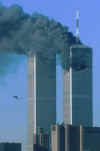
This blog has reported repeatedly on the issue and made suggestions. So you don’t have to hear my viewpoint this time, I strongly recommend a Wireless Week interview with Gregg Riddle, who advocates for public safety workers from his post as president of APCO International, the major trade association in the public safety area. I do not always agree with APCO, but what he says in this interview makes a lot of sense.
Here is a brief excerpt:
WW: How robust are the nation's public safety networks right now? If we had another terrorist attack, would we see the same breakdown in communications we did 10 years ago?
Riddle: It's very possible because we have not addressed the interoperability concern. Public safety operations today are spread out over multiple portions of the spectrum - VHF, UHF, 700 MHz, 800 MHz and low band. They all have their own interoperability capabilities, but when you have public safety utilizing multiple portions of the spectrum, they're not easily interoperable, which was demonstrated on Sept.11, 2001.
Interoperability is critical. It was one of the Sept. 11 Commission's report items that's not been met after 10 years – interoperability for public safety. We're still struggling to meet the goal as described in the report.
There is more than enough blame to go around here both in government entities who played political games and turf battles and corporate interests who wanted to use this situation for market hegemony and their financial benefit. But this is not the time for a postmortem on who has responsibility for this mess. Rather it is the time to remember the spirit of national unity that existed 10 years ago and use it to come up with a consensus solution and adopt it.
Does NTIA Have the Bureaucratic Courage to Measure Occupancy of 225-400 MHz?

“The NTIA shall seek to advance the following policies .. Fostering full and efficient use of telecommunications resources, including effective use of the radio spectrum by the Federal Government, in a manner which encourages the most beneficial uses thereof in the public interest.” 47 U.S.C. 901
The 2007 report shown at left is one of a pair of reports done by NTIA/ITS to measure occupancy of Federal Government “G” spectrum in urban areas. The other report was done in 2008 in the Denver area. Previous NTIA/ITS reports , such as the 1999 San Francisco report focused on signal levels, not occupancy and had explicit caveats about inferring occupancy:
“The spectrum survey measurements contained in this report cannot be used solely to assess the feasibility of using alternate services or systems in a band. Extrapolation of data in this report to general spectrum occupancy for alternative spectrum uses requires consideration of additional factors.”
The chart below shows the context of this selection of frequencies to be measured. The report covers a 12 MHz wide band and a 14 MHz wide band, both in the VHF/UHF region. However, the 175 MHz wide almost exclusively Federal Government band at 225-400 MHz is not mentioned at all. Why? Sources at NTIA ay the answer is simple: IRAC, NTIA’s “advisory committee” of federal users that helps them in “assigning frequencies to U.S. Government radio stations and in developing and executing policies, programs, procedures, and technical criteria pertaining to the allocation, management, and use of the spectrum” forbid them to measure that “beach front property”.
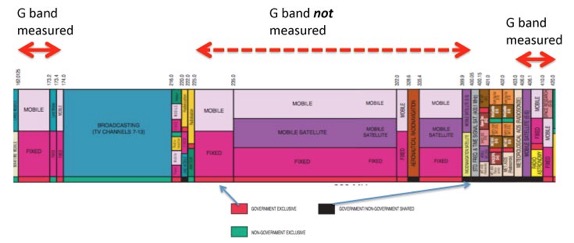
Why did IRAC not want to see data on the occupancy of that band? In almost all urban areas - the places where there is a shortage of commercial spectrum - the occupancy is low because the band is primarily used by military aircraft.
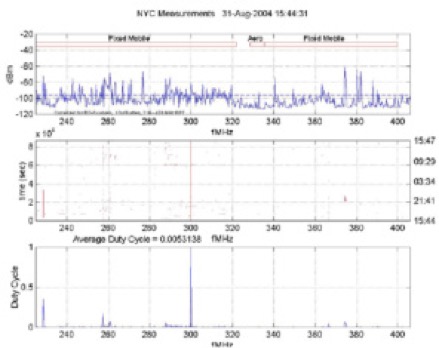
The above measurement by Shared Spectrum Corp. in New York City during the 2004 Republican National Convention shows the minimal use of this band even during a time of nearly unprecedented federal law enforcement and military presence in the city. FCC Spectrum Policy Task Force measurements showed similar results except in San Diego - the only major city with a military airfield near the center. (See Report of the Spectrum Efficiency Working Group, p. 10. The plot is labeled ‘ Occupancy of approximately 700 megahertz of spectrum below 1 GHz”, but actually is 200-900 MHz so the 225-400 MHz band is the left quarter of the horizontal axis. The report comments “it can be seen that there can be a large variation in spectrum use intensity within the spectrum below 1 GHz”.)
DoD’s concerns over measurement of this band are several.
- The low occupancy might lead naive policy makers to reallocate the band to other uses while the situation is more complicated. The band is heavily used in some rural areas for training and could be heavily used in emergencies even in urban areas. Thus they would argue that fire departments should not have the same spectrum loading as taxis since they have vital peak demands during emergencies. BUT, why hide the data and why not consider possible new spectrum use models based in “interruptible spectrum” concepts where DoD could preempt commercial use of the spectrum on a moment’s notice?
- Measurement of the band’s occupancy might reveal critical security information. Did the Shared Spectrum data above reveal such information? The Russians already have diplomatic facilities in New York, San Francisco, Seattle and Houston. The Chinese have them New York, Chicago, Houston, Los Angeles, and San Francisco. Thus key countries that have tensions with the US can readily measure for themselves the rough information given in spectrum occupancy studies. Withholding it from US policy makers and elected officials would not appear to be a valid security measure. There is no need to show which frequency channels are used vs. unused, a histogram of channel occupancies would be adequate for policy purposes. It is hard to believe that any channel occupancy data in this band reveals properly classified information.
- The US military has to negotiate for access to this band in other countries where we have bases and showing any “softness” in this band with respect to civil use might send the wrong signal to host countries. Probably. But spectrum is now a major input factor into GDP growth and making life easy for Politico-Military Affairs officers in US embassies overseas probably should not be a dominant factor in domestic spectrum decisions. New technologies could allow sharing of this band with preemption as discussed above and DoD and State department can explain to our allies how the new technology allows new options that they might wish to consider also.
During my nearly 25 yeas at FCC I never recall any NTIA hard data on the 225-400 MHz band use in urban areas - not even on a classified basis. Now without the promise of cognitive radio/dynamic spectrum access technology, sharing was not feasible for the reasons discussed above. But things have changed and new policy and technology options are now available. Shouldn’t we at least see some hard data on this key issue of how much this band is used in the areas of major spectrum congestion?

Photo from CIA Headquarters
UPDATE
See http://www.marcus-spectrum.com/Blog/files/SpecMeasCorr414.html
Snowe/Kerry Spectrum Bill
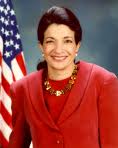

U.S. Senators Olympia J. Snowe (R-Maine) and John Kerry (D-Mass.) today introduced the Spectrum Measurement and Policy Reform Act, comprehensive spectrum reform legislation to modernize the nation’s radio spectrum planning, management, and coordination activities.
“This legislation will lay the groundwork to develop a strong and effective 21st century comprehensive spectrum policy that will provide consumers with additional choices, greater innovation, lower prices and more reliable services,” said Senator Snowe. “Our nation’s competitiveness, economic growth, and national security demand that we allocate the necessary attention to current policy shortcomings, and enactment of this vital legislation will help avert the looming spectrum crisis and allow us to continue to enjoy the boundless benefits of spectrum-based services.”
“Our nation’s airwaves are finite resources, and we need to use them as efficiently as possible,” Senator Kerry said. “This analysis will help us empower innovation, encourage competition, and lower prices for emerging technologies nationwide. Steps like this are essential to expanding broadband internet access while providing a platform where entrepreneurs can create new services and generate jobs. We can and should know how our spectrum is being used and do more to encourage more efficient and productive use. We look forward to working with the Administration and the communications community to move forward with this important legislation.”
Senators Snowe and Kerry, senior members of the Senate Committee on Commerce, Science, and Transportation and longtime champions of spectrum reform, designed the bipartisan measure to complement the Federal Communications Commission's (FCC) National Broadband Plan in promoting more efficient use of spectrum and ensuring that the proper framework is in place to meet the future telecommunications needs of the nation. Specifically, the Spectrum Measurement and Policy Reform Act tasks the FCC and the National Telecommunications and Information Administration (NTIA) to perform much needed spectrum measurements to determine actual usage and occupancy rates. This data will assist policymakers and the public in making informed decisions about future spectrum uses. In addition, the bill requires greater collaboration between the FCC and NTIA on spectrum policy and management related issues, implementation of spectrum sharing and reuse programs, as well as more market-based incentives to promote efficient spectrum use; and, sets a deadline for the creation of the National Strategic Spectrum Plan, which will provide a long-term vision for domestic spectrum use and strategies to meet those needs.
----------
Section 4(b)(1) 0f the bill requires NTIA and FCC to identify based on actual surveys:
(A) 120 megahertz below 4 gigahertz worth of close proximity electromagnetic spectrum that is most feasible for spectrum sharing opportunities for commercial and government users;
(B) 120 megahertz below 4 gigahertz worth of close proximity electromagnetic spectrum that is most feasible for spectrum reuse opportunities for commercial and government users;
(C) 120 megahertz below 4 gigahertz worth of electromagnetic spectrum that is most feasible for temporary or dynamic short-term assignment and use;
(D) 120 megahertz below 4 gigahertz worth of close proximity electromagnetic spectrum that is most feasible for spectrum layering opportunities for commercial and government users.
Section 6(b)(2) lets NTIA withhold spectrum from federal users, charge federal users an annual fee based on market value, and allows incentive awards for agencies that allow their spectrum to be auctioned
Section 6(g) creates an IRAC “shot clock” to require IRAC to “ act within 30 days” on certain items.
My sometimes clients at New America Foundation commented:
"We applaud Senators Kerry and Snowe for their forward-looking efforts to promote spectrum access and mobile broadband innovation," said Michael Calabrese, who directs the New America Foundation's Wireless Future Program. "The Kerry-Snowe bill maps a path to opening enormous amounts of grossly underutilized spectrum, especially federal government bands, for licensed, unlicensed and shared access by the private sector."
The more establishment trade organizations have not commented yet on the bill. I will add this comments when available.
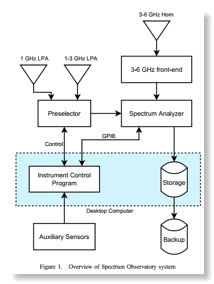
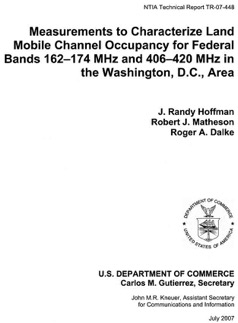



![Validate my RSS feed [Valid RSS]](valid-rss-rogers.png)

